Abstract
This study aims to evaluate the accuracy of semi-empirical models for determining infiltration based on the existing equations (Horton, Kostiakov and Kostiakov–Lewis) and a new form equation with optimized parameters which has good accuracy (lowest RMSE and MBE), sufficient linearity (highest R2), and a Willmott index close to 1. The location of this study was the Cisadane watershed, which is a priority watershed in Indonesia. The lowest values of average RMSE and MBE and highest values of R2 and Willmott index are given by Equation 1, which indicated that the model was closest to the field infiltration conditions. The distribution of the RMSE values for all survey points using Equation 1 resulted in small RMSE values ranging from 0.09 to 1.83. The distribution of R2 values for all survey points using Equation 1 yielded R2 values close to 1 (high linearity) with values ranging from 0.96 to 1. Based on these results, it can be concluded that Equation 1 is the most accurate infiltration model for the Cisadane watershed compared to the existing infiltration rate equation. This research can be used as an initial idea to create the infiltration rate model using other forms of equations with optimization parameters to produce a more representative model with field data.
1. Introduction
The infiltration process is an important hydrologic component that connects surface and subsurface water systems [1]. Infiltration has a significant impact on flood control, ecosystem health and function maintenance, and water conservation [2]. Additionally, determining the soil infiltration is essential for planning, assessing, and managing furrow irrigation systems [3]. The efficiency of water consumption and the efficiency of irrigation systems are directly impacted by the assessment of soil infiltration characteristics. Measuring the hydraulic properties of the soil surface is critical for solving various hydrological and ecological problems related to the storage and transport of water in the soil in the vadose zone [4]. However, under natural conditions, it is challenging to measure variations in infiltration directly. Therefore, one of the most important goals of hydrological research is to accurately estimate the infiltration process [5].
Many rainfall–runoff models rely on estimates of soil infiltration rates. However, these parameters are often based on relatively undisturbed soils or simplified physical models. The infiltration model, which uses infiltration time t as an input parameter, is a popular technique for calculating cumulative infiltration by soil water movement mechanisms or empirical formulas. Common infiltration models based on capillary potential theory were developed by Green and Ampt in 1911 [6]; models based on soil water potential were developed by Philip in 1957 [7]; and empirical and semi-empirical models were developed by Kostiakov (1932) [8], Horton (1933) [9], and Mezencev (1948) [10]. Two of the most commonly used semi-empirical models for determining infiltration in rainfall–runoff models are those of Horton and Kostiakov. Over the years, many studies have been developed using the Horton [11,12,13] and Kostiakov infiltration rate equation [14,15]. Along with the development of research, especially regarding infiltration rate models, the equations were also investigated further, resulting in several revised equations, including the Kostiakov–Lewis model. The Kostiakov–Lewis model is a modification of the Kostiakov model that includes the constant steady infiltration rate component. It eliminates the limitation of the Kostiakov model by including the infiltration rate at longer intervals [16]. The Horton method was also modified to deal with unsteady rainfall events by estimating infiltration capacity and ponding time using cumulative infiltration and infiltration capacity [17]. Infiltration capacity and ponding duration were also connected to actual cumulative infiltration in the modified equation [18].
The literature review reveals that some field research has been conducted to evaluate the accuracy of infiltration equations. Several studies have shown that the level of accuracy of the infiltration model (Horton, Kostiakov and Kostiakov Lewis) is quite good for field data with an R2 value > 0.9 [14]. However, in several other research studies, the infiltration model produced less accurate results when compared to field data [19,20]. The analysis of related sources revealed that the behaviors of the infiltration models varied depending on the land use, climate, and field situations. In the observed infiltration rate curve shape, the rate initially monotonously decreases and then stabilizes. This follows the typical ‘concave-to-linear’ infiltration curve shape examined by Horton and Kostiakov [21]. The ‘concave to linear’ curve has a similar form to other curves, including the rainfall intensity curve and the indifference curve [22]. The curve is concave, has a negative slope, and does not intersect. Therefore, in this study, we evaluated several additional equations with optimized parameters that result in a ‘concave-to-linear’ curve in order to see their suitability for field conditions.
One of the most popular techniques for testing the constant infiltration rate and cumulative infiltration of soil over a period of time in the field is the double-ring infiltration test [23]. The advantages of the double ring infiltrometer include simplicity, speed, and minimal water consumption. It is a repeatable and direct measurement method for studying the infiltration behavior of different soil levels and evaluating the rate of water infiltration into the soil over a short period [24]. The double ring infiltrometer works on the same concept as a single-ring infiltrometer with an additional ring attached circularly to the inner ring. This additional ring reduces the sideways ground flow and generates only a vertical flow within the inner ring [25].
This study was conducted in the Cisadane watershed. Owing to the change in land use, urbanized river basins, and watershed potential in the irrigation industry, this watershed is one of the priority watersheds in Indonesia. This study aims to evaluate a semi-empirical infiltration model using the existing infiltration rate equations (Horton, Kostiakov, and Kostiakov–Lewis) and an indifference equation form approach to obtain the most accurate infiltration model with field data calibration. This paper presents a brief overview of the study sites and research methodology consisting of data collection and the infiltration model used. In the final section, a discussion of research results will be presented consisting of the results of the infiltration model, model evaluation, and research conclusions that will summarize inferences from the results of the study, the limitations of the study, the implications of the results on existing technologies and research, and the future scope of the study.
2. Materials and Methods
2.1. Study Area, Experimental Method and Data Collection
The Cisadane watershed is a multi-provincial watershed in Indonesia, located mainly in West Java (75.5% of the total area) and Banten (24.5% of the total area) (Figure 1). Weather conditions in the Cisadane watershed have a relatively warm average temperature of 23.48 °C (with an average temperature of 21.23 °C upstream and an average temperature of 25.73 °C downstream). The upstream part of the watershed has a moderate-to-steep slope due to the influence of the Salak Mountains, whereas the downstream part has a relatively shallow slope. The annual rainfall in the upstream area ranged from 3200 to 3700 mm, whereas the annual rainfall in the downstream area was approximately 1583 mm. The Cisadane watershed is dominated by agricultural, residential, commercial, and forest areas. As the population has grown, land use has changed significantly over the past 10 years from recharge areas to impervious surface areas. Land use in the Cisadane watershed varied from upstream to downstream. The upper Cisadane watershed is still dominated by forests in mountainous and agricultural areas. Existing forests consist of primary, secondary, and plantation forests. In the last eight years (2011–2018), the forest area, especially plantation forests, has decreased from 8988 to 6544 ha. The downstream Cisadane watershed does not have sufficient catchment areas, as it is dominated by built-up areas such as residential and commercial areas. The percentage of total residential land in the Cisadane watershed increased from 15.3% in 2011 to 24.3% in 2018: a 9% increase over the previous eight years. Based on the soil texture, the dominant soil textures in the Cisadane watershed are fine sandy clay (53% of the total watershed area), loamy sand (25%), and sandy clay (22%).
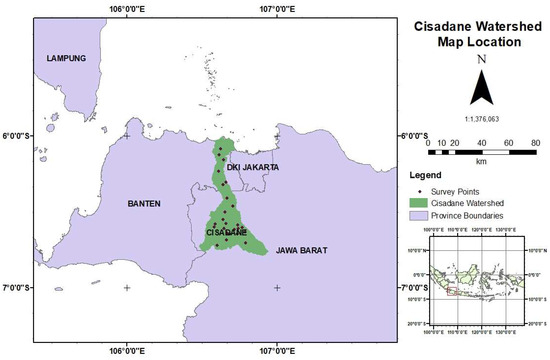
Figure 1.
Location study and survey points.
In this study, a limited number of survey points were used to measure infiltration rates with a double-ring infiltrometer. The points selected were based on medium, high, and very high potential recharge criteria and were distributed throughout the Cisadane watershed (Figure 1). There were 25 survey locations, consisting of 15 survey points upstream, 4 survey points midstream, and 6 survey points downstream. The number of survey points in the upstream was no more than 60% of the total number of survey points because of the wide shape of the Cisadane watershed in the upstream area. The characteristics of the survey points are listed in Table 1. The annual rainfall values are average annual rainfall data from 2010 to 2019 from the Indonesian Ministry of Public Works and Public Housing. Land use data were obtained from the Indonesian Ministry of Environment and Forestry in 2020. Soil texture data come from the Indonesian National Survey and Mapping Coordinating Agency (Bakosurtanal). Meanwhile, the slope is processed from DEM data.

Table 1.
Survey area characteristics.
A double-ring infiltrometer is one of the simplest and fastest instruments for testing infiltration rates in the field (Figure 2). It consists of inserting two open cylinders into the soil, one inside the other, filling them with water to a certain height, and then measuring the water level change rate on the ring per unit of time. The infiltration rate is often plotted against time and expressed in centimeters per hour (or inches per hour). Depending on the test objective, the maximum steady state or average incremental infiltration rate corresponded to the infiltration rate. Generally, after 120 min, the infiltration value reached a constant level, and the test was terminated [26]. However, if the infiltration rate was not constant, the test was continued until the infiltration water depth was adjusted.
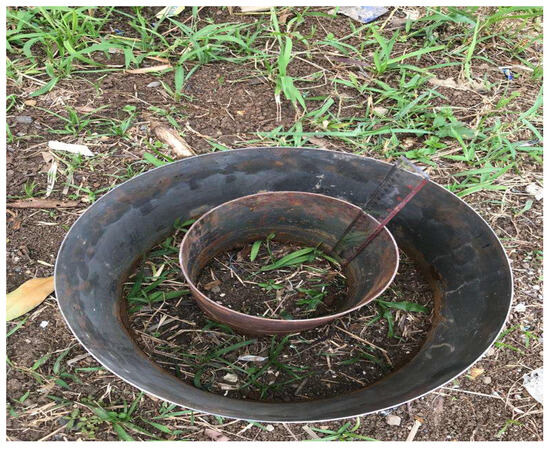
Figure 2.
Double-ring infiltrometer.
2.2. Infiltration Model
The infiltration models of Kostiakov [8], Kostiakov–Lewis [16], and Horton [9], as empirical models, were investigated to determine the best infiltration model for the conditions of this study. In addition, several equations that result in ‘concave-to-linear’ curves were evaluated for their suitability in modeling the infiltration rate. The additional equations evaluated are adopted from the equation of the rainfall intensity curve equation (IDF) with optimized parameters (a and b). The forms of IDF equations adopted include Talbot (Equation (1)) [27], Sherman (Equation (2)) [28] and Ishiguro (Equation (3)) [29]. The Talbot and Sherman equations are IDF equaions designed for regions of Asia with high rainfall, such as Indonesia [30]. This was the explanation behind selecting the version of the IDF equation adopted for the infiltration rate equation. The forms of infiltration equations evaluated in this study are listed in Table 2.

Table 2.
Water infiltration model.
2.3. Evaluation of Best Infiltration Model
The Kostiakov, Kostiakov–Lewis, and Horton infiltration model, and some indifference equations were evaluated to determine the best infiltration model under the conditions of this study. The best coefficients were selected based on the root mean square error (RMSE) and coefficient of determination (R2). The RMSE values represent the standard deviations of the differences between the measured and predicted values. The coefficient of determination (R2) indicates the extent to which the measured dispersion is represented by the predicted value dispersion [31]. The performance measures for the different criteria are as follows.
- Higher model performance is indicated by a smaller RMSE value [5]. The RMSE statistics perform best when the value is close to zero [19].
- A higher value of R2 represents a better fit of the model. R2 values of 0.7 < R2 < 1, 0.6 < R2 < 0.7, 0.5 < R2 < 0.6, and R2 < 0.5 were rated as very good, good, satisfactory, and unsatisfactory, respectively [32].
A statistical analysis was performed to determine how well the two models performed by determining the mean bias error (MBE) [33]. The main purposes of MBE are to estimate the model’s average bias and determine whether any action is necessary to correct the bias in the model [34]. To compare the accuracy of the best models, the Willmott index (d) is used [35,36]. A Willmott index value close to one indicates that a model captures field data well [37].
where fm is the infiltration rate model (cm/h), fo is the infiltration rate observed (cm/h) and n is the number of data points.
There are non-statistical parameters, such as Kruskal–Wallis, in addition to statistical parameters. Non-parametric methods compare populations without using specific parameters. These approaches do not examine whether there is a difference in the means of the populations but rather whether the locations of the populations differ [38]. The null hypothesis, H0, and alternative hypothesis, H1, for the Kruskal–Wallis test are as follows: H0 = the infiltration rate model to be compared in the test is the same; H1 = the infiltration rate model to be compared in the test is different.
3. Results
3.1. Observed Infiltration Rate Data
Based on the 25 monitoring points, the average infiltration rate varied from 0.676 to 7.652 cm/h (Table 3). The average infiltration rate at all survey points was 2.384 cm/h (medium infiltration). The Cisadane upstream watershed had a higher infiltration rate than the middle and downstream watersheds (Figure 3). The upstream watershed was dominated by medium-to-high infiltration rates with values ranging from 0.694 to 7.652 cm/h. Low to moderate infiltration rates predominated in the middle and downstream areas with values of 0.676–1.309 cm/h.

Table 3.
Infiltration rate data based on the ground test.
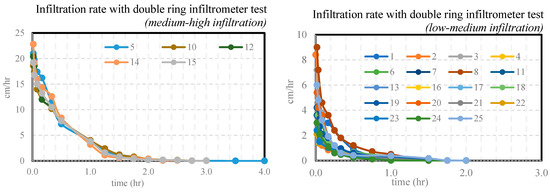
Figure 3.
Infiltration rate of point survey.
3.2. Infiltration Rate Model
The infiltration model was created from equations with coefficients obtained from observational data and/or optimization results. For previously developed infiltration equations (such as Horton, Kostiakov, and Kostiakov–Lewis), the equation coefficients were obtained from observed data. Based on the observed data, the parameters of Horton’s equation (k) vary from 2.01 to 7.15 with an average value of 3.92. For the parameters of Kostiakov and Kostiakov–Lewis models, the value of a varies from 0.03 to 0.89 with an average value of 0.25, while the value of b varies from −1.09 to −1.67 with an average value of −1.28 (Table 4). This study also attempted to evaluate other forms of infiltration rate modeling equations (Equations (1)–(3)) that contain coefficients a and b, which are optimized to produce the smallest error. From the optimization results, the value of the coefficient a varies within the following ranges: 0.2–5.03 with an average value of 1.20 (Equation (1)), 0.28–4.57 with an average value of 1.24 (Equation (2)), and 0.31–5.41 with an average value of 1.50 (Equation (3)). The value of the coefficient b varies within the following ranges: 0.03–0.22 with an average value of 0.10 (Equation (1)), 0.42–0.74 with an average value of 0.53 (Equation (2)), and 0–0.1 with an average value of 0.023 (Equation (3)) (Table 4). The equations developed in this study for the infiltration model are listed in Table 5. Figure 4 shows an example of a comparison curve between the infiltration rates of the observed data and the model results at survey points 1–8. From the comparison curve, it can be seen that the observed infiltration rate and the infiltration rate of the developed model are not significantly different.

Table 4.
Coefficient of infiltration rate models.

Table 5.
Infiltration rate equation.
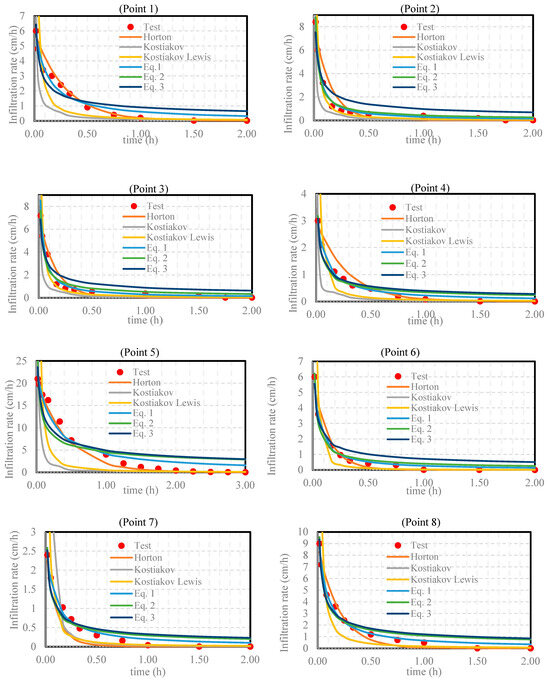
Figure 4.
Example of infiltration rate model comparison (points 1–8).
4. Discussion
Droughts and floods have significant effects in Indonesia in several administrative provinces. The government is currently facing freshwater supply problems, such as those in Java and the Sumatra Islands, where freshwater demand is highest. The changing environment due to development also has negative effects on the stability of the groundwater and negatively affects the community and ecosystem [39]. The behavior of the infiltration models differed also depending on the field conditions, climate, and land use. Compared to all other land uses, infiltration capacities were significantly greater in forest and low-development areas [20]. Furthermore, the type of land use had a significant influence on how the initial soil moisture conditions affected the infiltration behavior [24]. From the results of field measurements, the greatest infiltration rates at points 5, 10, 12, 14, and 15 are located in areas with forest and plantation land uses (low-development areas). On the other hand, areas with a majority of development land, such as residential areas, have low–medium infiltration rates.
Considering the importance of infiltration rate modeling in water resources management, the accuracy of the infiltration model is essential. This research resulted in an evaluation of various infiltration rate equations that had been developed previously (Horton, Kostiakov and Kostiakov–Lewis) and additional equations adopted for the infiltration rate model with optimization parameters (a,b). Figure 5 and Figure 6 show the relationship between parameters a,b, the initial infiltration rate and constant infiltration rate as measured by the double-ring infiltrometer. Parameter ‘a’ in Equations (1)–(3) has a strong linear relationship with the initial infiltration rate and constant infiltration rate in the field (R2 > 0.74). Meanwhile, parameter b only has a fairly good linear relationship with the field infiltration rate in Equations (1) and (3) (R2 > 0.59).
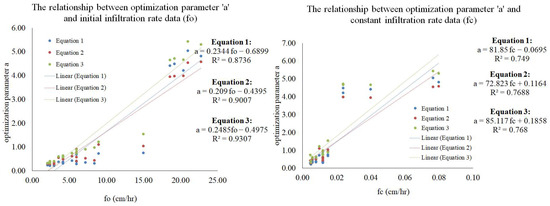
Figure 5.
The linear relationship between optimization parameter ‘a’, initial infiltration rate (fo), and constant infiltration (fc).
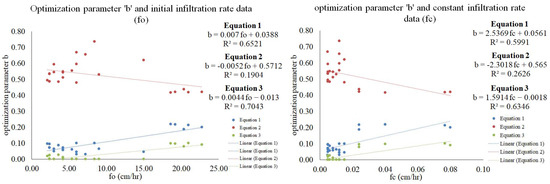
Figure 6.
The linear relationship between optimization parameter ‘b’, initial infiltration rate (fo), and constant infiltration (fc).
The lowest RMSE value indicates the highest predictive performance. Based on the six infiltration models tested, the lowest value of the average RMSE was 0.49 for Equation 1, indicating that the model is the closest to the infiltration conditions in the field. The highest value of average RMSE was 7.64 for the Kostiakov equation, indicating that the equation is not sufficiently representative of infiltration conditions in the study area. In addition to the RMSE, the linearity of the model was observed using the value of the coefficient of determination (R2). A higher value of R2 represents better linearity between the observed data and the model. The highest value of R2 was 0.98 for Equation (1), whereas the lowest value of R2 was 0.73 for the Kostiakov and Kostiakov–Lewis models (Table 6). The distribution of the RMSE values for all survey points using Equation (1) yielded small RMSE values ranging 0.09–1.83. The distribution of R2 values for all survey points using Equation (1) produced R2 values close to 1 (high linearity) with values ranging from 0.96 to 1 (Figure 7 and Figure 8). Therefore, Equation (1) is the closest equation and has the highest linearity with the experimental data (Figure 9). The results of this study can be used as a basic idea for further research especially on the topic of semi-empirical infiltration models.

Table 6.
RMSE and coefficient of determination (R2).

Figure 7.
Distribution value of R2 for all survey points.

Figure 8.
Distribution value of RMSE for all survey points.

Figure 9.
Average value of calibration parameter for each model.
The MBE’s primary objectives are to calculate the average bias of the model. From the results of comparing the MBE values of the infiltration rate model, the smallest MBE parameters are obtained for Equations (1)–(3) and Horton, as shown in Figure 10. Meanwhile, the infiltration rate model using the Kostiakov and Kostiakov Lewis equations has quite a large value of MBE when compared with the measured infiltration rate in the Cisadane watershed. Based on the distribution of MBE values per survey point, the infiltration rates in Equations (2) and (3) and Horton have larger outlier data than that in Equation (1). Therefore, based on the MBE value and distribution, Equation (1) has the smallest MBE value and the fewest outliers out of all the infiltration rate equations. A Willmott index value (d) close to one suggests that a model accurately captures field data. The Willmott index for the infiltration rates in Equations (1)–(3) and Horton is quite large, approaching 1 (>0.9); this indicates that the infiltration rates in Equations (1)–(3) and Horton are quite representative of field infiltration rate data in the Cisadane watershed. Meanwhile, the smallest Willmott index is for the Kostiakov and Kostiakov–Lewis infiltration rate models with d values for all survey points ranging from 0.4 to 0.8 (Figure 11).

Figure 10.
Distribution value of MBE for all survey points.

Figure 11.
Distribution value of Wilmott agreement index (d) for all survey points.
This research also uses non-statistical parameter analysis (Kruskal–Wallis) to determine whether there are significant differences between model infiltration rates and field measurements. The Kruskal–Wallis parameter value (H) was obtained by grouping the field infiltration rate with the infiltration rate of each model. The parameter values obtained were then compared with the critical value = 3.84 (df = 1 and alpha = 5%). From the analysis results, it was obtained that the H value < critical value in the 1, 2, 3 and Horton model infiltration rate equations (with the smallest H value produced by Equation (1) = 0.011), while for the Kostiakov and Kostiakov–Lewis infiltration rate equations, the H value was much greater than the critical value (Figure 12). There is no significant difference between the initial infiltration rate data from field measurements and Equations (1)–(3) and Horton infiltration rate models; however, the initial infiltration rate population of the Kostiakov and Kostiakov–Lewis models has a quite significant differences with the field data.
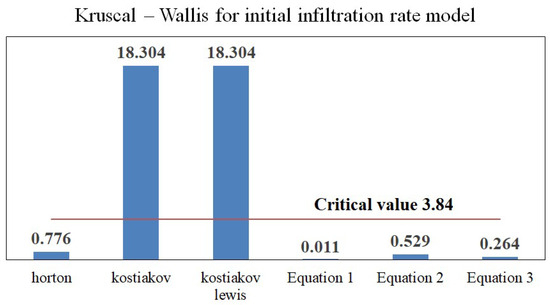
Figure 12.
Kruskal–Wallis value for initial infiltration rate model.
5. Conclusions
A double-ring infiltrometer is a simple instrument for measuring field infiltration rate. The Cisadane upstream watershed had a higher infiltration rate than the middle and downstream watersheds. Based on the 25 monitoring points, the average infiltration rate varied from 0.676 to 7.652 cm/h. In Equations (1)–(3), the parameter ‘a’ shows a strong linear relationship with the initial infiltration rate and constant infiltration rate in the field (R2 >0.74). Additionally, in Equations (1) and (3), parameter b only has a good linear relationship with the field infiltration rate (R2 > 0.59). Among the various infiltration rate equations, Equation (1) has the smallest MBE value and the fewest outliers based on the MBE value and distribution. The same thing was also obtained from Kruskal–Wallis’ non-statistical parameter analysis, where the infiltration rate in Equation (1) produces the smallest H value, which is far below the critical value. Based on the evaluation model result, it can be concluded that Equation (1) is the best-fitting infiltration model for the Cisadane watershed case with the lowest average RMSE value of 0.49 and the highest R2 value of 0.98. The results of this study can be used as initial research to find new equations with optimization parameters that produce better model accuracy than the existing equation, in this case, especially the infiltration rate model. This study was limited to a total of 25 survey points used, and the survey was carried out in one measurement. For future research, it is possible to evaluate the model with a larger number of survey points and multiple measurements to produce a more representative equation for calculating the infiltration rate. In addition, Equation (1) can be evaluated for its suitability for other watersheds.
Author Contributions
Conceptualization, D.P.A.H., S.L.W.D. and M.F.; methodology, D.P.A.H.; software, D.P.A.H. and M.F.; validation, D.P.A.H., S.L.W.D. and M.F.; formal analysis, D.P.A.H.; investigation, D.P.A.H.; resources, D.P.A.H.; data curation, D.P.A.H.; writing—original draft preparation, D.P.A.H.; writing—review and editing, D.P.A.H. and M.F.; visualization, D.P.A.H.; supervision, S.L.W.D. and M.F.; project administration, S.L.W.D.; funding acquisition, S.L.W.D. All authors have read and agreed to the published version of the manuscript.
Funding
This research was funded by Institut Teknologi Bandung through Excellent Research of Institute for Research and Community Service. The doctoral study fee is sponsored by Trisakti University.
Data Availability Statement
The data that support this study can be accessed upon reasonable request from the corresponding author’s email.
Acknowledgments
The authors would like to thank the Institut Teknologi Bandung and Universitas Trisakti for their support in this research and the reviewers for their helpful comments in improving the quality of the manuscript.
Conflicts of Interest
The authors declare no conflict of interest.
References
- Morbidelli, R.; Corradini, C.; Saltalippi, C.; Flammini, A.; Dari, J.; Govindaraju, R.S. Rainfall infiltration modeling: A review. Water 2018, 10, 1873. [Google Scholar] [CrossRef]
- Yang, M.; Zhang, Y.; Pan, X. Improving the Horton infiltration equation by considering soil moisture variation. J. Hydrol. 2020, 586, 124864. [Google Scholar] [CrossRef]
- Amami, R.; Ibrahimi, K.; Sher, F.; Milham, P.; Ghazouani, H.; Chehaibi, S.; Hussain, Z.; Iqbal, H.M.N. Impacts of different tillage practices on soil water infiltration for sustainable agriculture. Sustainability 2021, 13, 3155. [Google Scholar] [CrossRef]
- Moret-Fernández, D.; Latorre, B.; Lassabatere, L.; Di Prima, S.; Castellini, M.; Yilmaz, D.; Angulo-Jaramilo, R. Sequential infiltration analysis of infiltration curves measured with disc infiltrometer in layered soils. J. Hydrol. 2021, 600, 126542. [Google Scholar] [CrossRef]
- Panahi, M.; Khosravi, K.; Ahmad, S.; Panahi, S.; Heddam, S.; Melesse, A.M.; Omidvar, E.; Lee, C.-W. Cumulative infiltration and infiltration rate prediction using optimized deep learning algorithms: A study in Western Iran. J. Hydrol. Reg. Stud. 2021, 35, 100825. [Google Scholar] [CrossRef]
- Green, W.H.; Ampt, G.A. Studies on Soil Physics. J. Agric. Sci. 1911, 4, 1. [Google Scholar] [CrossRef]
- PHILIP, J.R. Theory of Infiltration; Academic Press, INC.: Cambridge, MA, USA, 1969; Volume 5. [Google Scholar]
- Kostiakov, A.N. On the dynamics of the coefficient of water percolation in soils and on the necessity of studying it from a dynamic point of view for purposes of amelioration. Trans. 6th Cong. Int. Soil Sci. Part A 1932, 17–21. [Google Scholar]
- Horton, R.E. The role of infiltration in the hydrology cycle. Trans. Am. Geophys. Union 1933, 14, 446–460. [Google Scholar]
- Mezencev, V.J. Theory of formation of the surface runoff. Meteorol. Hidrol. 1948, 3, 33–40. (In Russian) [Google Scholar]
- Ren, X.; Hong, N.; Li, L.; Kang, J.; Li, J. Effect of infiltration rate changes in urban soils on stormwater runoff process. Geoderma 2020, 363, 114158. [Google Scholar] [CrossRef]
- Bamutaze, Y.; Tenywa, M.M.; Majaliwa, M.J.G.; Vanacker, V.; Bagoora, F.; Magunda, M.; Obando, J.; Wasige, J.E. Infiltration characteristics of volcanic sloping soils on Mt. Elgon, Eastern Uganda. Catena 2010, 80, 122–130. [Google Scholar] [CrossRef]
- Swathi, V.; Raju, K.S.; Singh, A.P. Application of Storm Water Management Model to an Urban Catchment. In Hydrologic Modeling Select Proceedings of ICWEES-2016; Springer: Singapore, 2018; pp. 175–184. [Google Scholar] [CrossRef]
- Bayabil, H.K.; Dile, Y.T.; Tebebu, T.Y.; Engda, T.A.; Steenhuis, T.S. Evaluating infiltration models and pedotransfer functions: Implications for hydrologic modeling. Geoderma 2019, 338, 159–169. [Google Scholar] [CrossRef]
- Babaei, F.; Zolfaghari, A.A.; Yazdani, M.R.; Sadeghipour, A. Spatial analysis of infiltration in agricultural lands in arid areas of Iran. Catena 2018, 170, 25–35. [Google Scholar] [CrossRef]
- Lewis, M.R. The rate of infiltration of water in irrigation-practice. Trans. Am. Geophys. Union 1937, 18, 361–368. [Google Scholar] [CrossRef]
- Verma, S. Modified Horton’s infiltration equation. J. Hydrol. 1982, 58, 383–388. [Google Scholar] [CrossRef]
- Rossman, L.A. Storm Water Management Model User’s Manual Version 5.0. EPA/600/R-05/040. In Storm Water Management Model User’s Manual; United States Environmental Protection Agency: Cincinnati, OH, USA, 2010. [Google Scholar]
- Xin, Y.; Xie, Y.; Liu, Y. Effects of Residue Cover on Infiltration Process of the Black Soil Under Rainfall Simulations. Water 2019, 11, 2593. [Google Scholar] [CrossRef]
- Bergeson, C.B.; Martin, K.L.; Doll, B.; Cutts, B.B. Soil infiltration rates are underestimated by models in an urban watershed in central North Carolina, USA. J. Environ. Manag. 2022, 313, 115004. [Google Scholar] [CrossRef]
- Pachepsky, Y.; Karahan, G. On shapes of cumulative infiltration curves. Geoderma 2022, 412, 115715. [Google Scholar] [CrossRef]
- Komlos, J. Behavioral Indifference Curves. 2014. Available online: http://www.nber.org/papers/w20240 (accessed on 10 June 2014).
- Li, M.; Liu, T.; Duan, L.; Luo, Y.; Ma, L.; Wang, Y.; Zhou, Y.; Chen, Z. Scale transfer and simulation of the infiltration in chestnut soil in a semi-arid grassland basin. Ecol. Eng. 2020, 158, 106045. [Google Scholar] [CrossRef]
- Ruggenthaler, R.; Meißl, G.; Geitner, C.; Leitinger, G.; Endstrasser, N.; Schöberl, F. Investigating the impact of initial soil moisture conditions on total infiltration by using an adapted double-ring infiltrometer. Hydrol. Sci. J. 2016, 61, 1263–1279. [Google Scholar] [CrossRef]
- Warsi, T.; Kumar, V.S.; Dhakate, R.; Manikyamba, C.; Rao, T.V.; Rangarajan, R. An integrated study of electrical resistivity tomography and infiltration method in deciphering the characteristics and potentiality of unsaturated zone in crystalline rock. HydroResearch 2019, 2, 109–118. [Google Scholar] [CrossRef]
- ASTM-D3385–18; Infiltration Rate of Soils in Field Using Double Ring Infiltrometer. ASTM International: West Conshohocken, PA, USA, 2021; Volume I, pp. 1–8.
- Munawaroh, N.; Puspitasari, N.N.A.; Hadi, M.P.; Suarma, U. The comparison of rainfall intensity analysis methods in upstream area of Belik Watershed, Yogyakarta. IOP Conf. Ser. Earth Environ. Sci. 2020, 451, 012090. [Google Scholar] [CrossRef]
- Sherman, C.W. Frequency and Intensity of Excessive Rainfalls at Boston, Massachusetts. Trans. Am. Soc. Civ. Eng. 1931, 95, 951–960. [Google Scholar] [CrossRef]
- Khansa, P.; Sofiyah, E.S.; Suryawan, I.W.K. Determination of Rain Intensity Based on Rain Characteristics Observed from Rain Observation Stations Around South Jakarta. J. Adv. Civ. Environ. Eng. 2020, 3, 94–103. [Google Scholar] [CrossRef]
- Minh, H.V.T.; Lavane, K.; Lanh, L.T.; Thinh, L.V.; Cong, N.P.; Ty, T.V.; Downes, N.K.; Kumar, P. Developing Intensity-Duration-Frequency (IDF) Curves Based on Rainfall Cumulative Distribution Frequency (CDF) for Can Tho City, Vietnam. Earth 2022, 3, 866–880. [Google Scholar] [CrossRef]
- Atta-Darkwa, T.; Asare, A.; Amponsah, W.; Oppong, E.D.; Agbeshie, A.A.; Budu, M.; Larbi, I.; Akolgo, G.A.; Quaye, D.N.D. Performance evaluation of infiltration models under different tillage operations in a tropical climate. Sci. Afr. 2022, 17, e01318. [Google Scholar] [CrossRef]
- Moriasi, D.N.; Arnold, J.G.; van Liew, M.W.; Bingner, R.L.; Harmel, R.D.; Veith, T.L. Model Evaluation Guidelines for Systematic Quantification of Accuracy in Watershed Simulations. Trans. ASABE 2007, 50, 885–900. [Google Scholar] [CrossRef]
- Carlander, J.; Trygg, K.; Moshfegh, B. Integration of measurements and time diaries as complementary measures to improve resolution of BES. Energies 2019, 12, 2072. [Google Scholar] [CrossRef]
- Corrado, V.; Fabrizio, E. Steady-State and Dynamic Codes, Critical Review, Advantages and Disadvantages, Accuracy, and Reliability; Elsevier Inc.: Amsterdam, The Netherlands, 2018. [Google Scholar]
- Willmott, C.J. On the validation of models. Phys. Geogr. 1981, 2, 184–194. [Google Scholar] [CrossRef]
- Moges, D.M.; Virro, H.; Kmoch, A.; Cibin, R.; Rohith, A.; Martínez-Salvador, A.; Conesa-García, C.; Uuemaa, E. How does the choice of DEMs affect catchment hydrological modeling? Sci. Total Environ. 2023, 892, 164627. [Google Scholar] [CrossRef]
- Khai, W.J.; Sami, B.F.Z.; Fai, C.M.; Essam, Y.; Ahmed, A.N.; El-Shafie, A. Investigating the reliability of machine learning algorithms as a sustainable tool for total suspended solid prediction. Ain Shams Eng. J. 2021, 12, 1607–1622. [Google Scholar] [CrossRef]
- Mbuli, N.; Mendu, B.; Pretorius, J.-H.C. Statistical analysis of forced outage duration data for subtransmission circuit breakers. Energy Rep. 2022, 8, 1424–1433. [Google Scholar] [CrossRef]
- Janottama, S.Z.; Triana, K. Delineating the groundwater protection zone (GPZ) around a water supply plant in Bekasi, West Java, Indonesia. Groundw. Sustain. Dev. 2022, 17, 100762. [Google Scholar] [CrossRef]
Disclaimer/Publisher’s Note: The statements, opinions and data contained in all publications are solely those of the individual author(s) and contributor(s) and not of MDPI and/or the editor(s). MDPI and/or the editor(s) disclaim responsibility for any injury to people or property resulting from any ideas, methods, instructions or products referred to in the content. |
© 2023 by the authors. Licensee MDPI, Basel, Switzerland. This article is an open access article distributed under the terms and conditions of the Creative Commons Attribution (CC BY) license (https://creativecommons.org/licenses/by/4.0/).